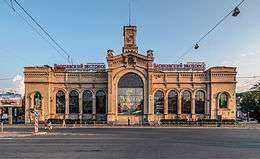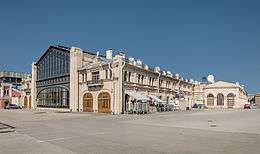Varshavsky railway station


Varshavsky station (Russian: Варша́вский вокза́л, Varshavsky vokzal), or Warsaw station, is a former passenger railway station in Saint Petersburg, Russia, now home of the Central Museum of Railway Transport, Russian Federation.
History
The station was originally built in 1851 for a rail line, completed in 1858, from the city to the Tsar's residence in Gatchina. The line was extended in 1859 to Pskov and in 1862 to Warsaw, which at that time was a part of Congress Poland and the Russian Empire. A branch from the main line that ran to the Prussian border at Virbalis (now Lithuania) connected Saint Petersburg to other capitals of Europe.
The current building was designed by Piotr Salmanovich in a mixture of historical styles. It was constructed between 1857 and 1860. A church was built in front of the station in 1908; it was later demolished and a Lenin statue by Soviet sculptor Nikolai Tomsky appeared in 1949.
In 2001, the station was closed, with long distance rail service diverted to Vitebsky railway station and commuter service to Baltiysky Rail Terminal, and the depiction of Lenin removed. The trade center Warsaw Express has occupied the building since 2005. On the tracks, a railway museum now holds over 80 exhibits of steam engines, electric and diesel locomotives. Museum complex is closed, and will be moved, and opened at balikski station in 2017
Gallery
- Em 730 31 0-10-0 at Varshavsky station St.Petersburg
.jpg) Russian locomotive class O Ov 6640 at Varshavsky station
Russian locomotive class O Ov 6640 at Varshavsky station.jpg) Esh 4444 0-10-0 at Varshavsky Rail Terminal St.Petersburg
Esh 4444 0-10-0 at Varshavsky Rail Terminal St.Petersburg.jpg) Russian locomotive class Yea 2201 at Varshavsky Rail Terminal
Russian locomotive class Yea 2201 at Varshavsky Rail Terminal.jpg) Russian locomotive class FD 20-1103 at Varshavsky station
Russian locomotive class FD 20-1103 at Varshavsky station.jpg) 2-10-0 Russian locomotive class TE 6769 at Varshavsky station
2-10-0 Russian locomotive class TE 6769 at Varshavsky station.jpg)
.jpg) ChS1-041 at the Central Museum of Railway Transport, Russian Federation, at Varshavsky station
ChS1-041 at the Central Museum of Railway Transport, Russian Federation, at Varshavsky station.jpg) ChS2-023 at the Central Museum of Railway Transport, Russian Federation, at Varshavsky station
ChS2-023 at the Central Museum of Railway Transport, Russian Federation, at Varshavsky station.jpg) D1 multiple unit D1 719-3 at the Central Museum of Railway Transport, Russian Federation, at Varshavsky station
D1 multiple unit D1 719-3 at the Central Museum of Railway Transport, Russian Federation, at Varshavsky station.jpg) M62 locomotive M62-1 at the Central Museum of Railway Transport, Russian Federation, at Varshavsky station
M62 locomotive M62-1 at the Central Museum of Railway Transport, Russian Federation, at Varshavsky station.jpg) TEP70-0007 at the Central Museum of Railway Transport, Russian Federation, at Varshavsky station
TEP70-0007 at the Central Museum of Railway Transport, Russian Federation, at Varshavsky station.jpg) ChS4-012 at the Central Museum of Railway Transport, Russian Federation, at Varshavsky station
ChS4-012 at the Central Museum of Railway Transport, Russian Federation, at Varshavsky station.jpg) ChME3-001 at Central Museum of Railway Transport, Russian Federation, at Varshavsky station.This is the first locomotive of this class.
ChME3-001 at Central Museum of Railway Transport, Russian Federation, at Varshavsky station.This is the first locomotive of this class..jpg) Sole surviving RT-23 Molodets missile system at the Varshavsky station
Sole surviving RT-23 Molodets missile system at the Varshavsky station.jpg) MK-3-12 at the Central Museum of Railway Transport, Russian Federation, at Varshavsky station
MK-3-12 at the Central Museum of Railway Transport, Russian Federation, at Varshavsky station.jpg) Industrial Fireless locomotive No.9305 at the Central Museum of Railway Transport, Russian Federation, at Varshavsky station. Built by Maschienenfabrik L. Schwarzkopff in Germany for the USSR in 1928. It worked at the Tuapse oil refinery.
Industrial Fireless locomotive No.9305 at the Central Museum of Railway Transport, Russian Federation, at Varshavsky station. Built by Maschienenfabrik L. Schwarzkopff in Germany for the USSR in 1928. It worked at the Tuapse oil refinery.
See also
- The Museum of the Moscow Railway, at Paveletsky railway station, Moscow
- Rizhsky railway station, Home of the Moscow Railway Museum
- History of rail transport in Russia
- List of railway museums (worldwide)
- Heritage railways
- List of heritage railways
- Restored trains
- Finland Station, St.Petersburg
Sources
External links
| Wikimedia Commons has media related to Varshavsky station (Saint Petersburg). |
- Station site with many images
- Report on a visit to the Varshavsky station
- The Museum of the Moscow Railway Photographs
- Lenin's Funeral Train Photographs
- Paveletsky Rail station Official site
- The Moscow Railway Museum at Rizhsky railway station, Moscow
- 156 photos of the Varshavsky Station Railway Museum
Coordinates: 59°54′28″N 30°18′26″E / 59.9077°N 30.3072°E